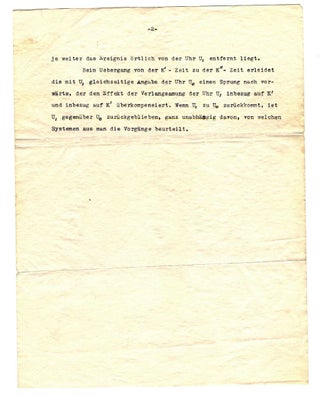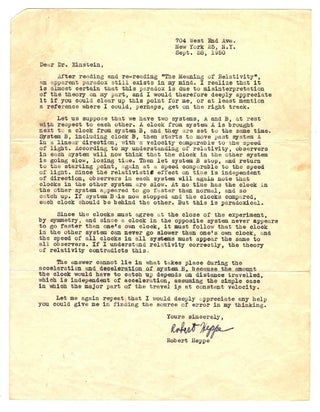Typed Letter with Autograph Corrections on Special Relativity
EINSTEIN DISCUSSES A “TIME PARADOX” OF SPECIAL RELATIVITY, PROVIDING A DETAILED EXPLANATION OF ONE OF THE CORE ELEMENTS OF HIS THEORY.
Einstein’s letter is in response to an inquiry from the scientist Robert Heppe, who is seeking clarification on an apparent paradox arising from special relativity.
Heppe writes to Einstein:
Dear Dr. Einstein,
After reading and re-reading "The Meaning of Relativity", an apparent paradox still exists in my mind. I realize that it is almost certain that this paradox is due to misinterpretation of the theory on my part, and I would therefore deeply appreciate it if you could clear up this point for me…
Heppe then proceedes to describe an apparent paradox in the theory of special relativity, specifically noting a problem incorporating the supposed directional independence of relativistic effects for two systems (with clocks) into a situation whereby the systems, after a period of moving at different relative velocities, end up back at the initial conditions.
In particular, Heppe concludes:
Since the clocks [in the systems] must agree at the close of the experiment, by symmetry, and since a clock in the opposite system never appears to go faster than one's own clock, it must follow that the clock in the other system can never go slower than one's own clock, and the speed of all clocks in all systems must appear the same to all observers. If I understand relativity correctly, the theory of relativity contradicts this.
Einstein, in response, explains [translated from the original German]:
The paradox - in the words of the special theory of relativity – has its roots in the following:
Time is defined by the sum of the indications of the clocks which are tuned equally in an inertial system. If I now introduce a new inertial system with a different motion situation, by changing the motion situation of the system including its clocks, then the clocks, which were synchronized before the change, are no longer synchronized.
If I have a clock Uo at the origin pt. of the motionless system K [diagram] and a clock U1 moving at a velocity of V in an inertial system K', then U1 is running slower than the motionless clock (Uo), if we observe U1 from system K of the motionless clocks. It therefore makes no sense to say “U1 runs slower than Uo”, one rather has to add: in relation to the clock system K. Because without introducing the clock system there is no possibility to compare a clock U2 with U1, after it is removed from U1.
However, if I pose the question how Uo runs relative to U1, I have to introduce synchronized clocks in K'.
The result then is that Uo runs slower than U1, if Uo is compared to that clock in K' which is just passing by Uo.
If I now consider the movement of U1 in P(K?) , then I must introduce a new inertial system K'' with a system of clocks that are motionless relative to K''. With the transition from K' to K'', I introduce a new time which, the further the occurrence is physically removed from the clock U1, the more different it is from the time in K' although the display of U1 doesn’t change with a change in velocity.
During the transition from K'-time to K''-time, the display of the Uo clock that is synchronous with the corresponding U1 clock will jump ahead, so that the slowing effect of clock U1 in relation to K' is in relation to K' over(?)compensated.
When U1 returns to Uo, U1 has fallen behind Uo, totally independent of the system from which one observes these occurrences.
One sheet (two sides) in German, typed with diagram and notes in Einstein’s hand. With copy of Heppe’s letter from September 28, 1950. Expected folds, a little toning.
Note: The letter is not signed by Einstein and might be a draft of a letter.
AN EXCEEDINGLY RARE EXAMPLE OF EINSTEIN EXPLAINING ONE OF THE CORE ASPECTS OF SPECIAL RELATIVITY.
Check Availability:
P: 212.326.8907
E: michael@manhattanrarebooks.com



